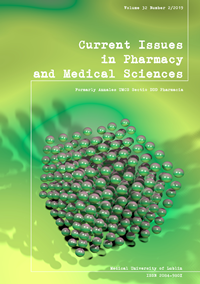Medical textiles with silver/nanosilver and their potential application for the prevention and control of healthcare-associated infections – mini-review
DOI:
https://doi.org/10.2478/cipms-2019-0020Keywords:
healthcare-associated infections (HAI), prevention, antimicrobial textiles, silver/nanosilverAbstract
Healthcare-associated infections (HAI), especially those in hospitalized patients, can be regarded as an important public health problem worldwide. In this article we presented an overview on the use of antimicrobial textiles, including those with silver/nanosilver, as a new approach to countering HAI by reducing the potential risk of the pathogen transmission between patients and healthcare workers. The strong antimicrobialin vitroactivity of these engineered textiles was confirmedin vitroagainst several HAI-associated pathogens, including multiresistant strains belonging to alert pathogens. However, according to literature data, the sole use of antimicrobial clothing by healthcare workers appears to not be sufficient for the prevention and control of HAI. Further comprehensive and controlled studies are needed to assess the real-time efficacy of the antimicrobial textiles in healthcare settings. Moreover, there is a need to control the silver use not only for medical applications, but also for non-medical purposes due to a possibility for the emergence and spread of silver resistance among microorganisms, especially Gram-negative bacteria.
References
2. Brouqui P, Boudjema S, Soto Aladro A, Chabrière E, Florea O, Nguyen H et al. New approaches to prevent healthcare-associated infection. Clin Infect Dis. 2017;15:65(suppl_1):S50-S54.
3. Dunne C, Keinänen-Toivola MM, Kahru A, Teunissen B, Olmez H, Gouveia I et al. Anti-microbial coating innovations to prevent infectious diseases (AMiCI): Cost action ca15114. Bioengineered. 2017;2:8(6):679-85.
4. Mitchell A, Spencer M, Edmiston Jr C. Role of healthcare apparel and other healthcare textiles in the transmission of pathogens: a review of the literature. J Hosp Infect. 2015;90:285-92.
5. McArthur JV, Tuckenfield RC, Baker-Austin C. Antimicrobial textiles. Handb Exp Pharmacol. 2012;211:135-512.
6. Morais DS, Guedes RM, Lopes MA. Antimicrobial approaches for textiles: from research to market. Materials (Basel). 2016;9:Doc21. doi: 10.3390/ma9060498.
7. Windler L, Height M, Nowack B. Comparative evaluation of antimicrobials for textile applications. Environ Int. 2013;53:62-73.
8. Zhang S, Tang Y, Vlahovic B. A review on preparation and applications of silver-containing nanofibers. Nanoscale Res Lett. 2016;11:80.
9. Barras F,Aussel L, Ezraty B. Silver and antibiotic, new facts to an old story. Antibiotics 2018;7:79.
10. Likus W, Bajor G, Siemianowicz K. Nanosilver – does it have only one face? Acta Biochim Polon. 2013;60(4):495-501.
11. Panáček A, Kvítek L, Smékalová M, Večeřová R, Kolář M, Röderová M et al. Bacterial resistance to silver nanoparticles and how to overcome it. Nature Nanotechnol. 2018;13:65-71.
12. Randall CP, Gupta A, Jackson N, Busse D. O`Neil AJ. Silver resistance in Gram-negative bacteria: a dissection of endogenous and exogenous mechanisms. J Antimicrob Chemother. 2015;70:1037-46.
13. Cavassin ED, de Figuereido LFP, Otoch JP, Seckler MM, de Oliveira RA, Franco FF et al. Comparison of methods to detect the in vitro activity of silver nanoparticles (AgNP) against multidrug resistant bacteria. J Nanobiotechnol. 2015;13:64. doi: 10.1186/s12951-015-0120-6
14. Hasse H, Jordan L, Keitel L, Keil C, Mahltig B. Comprison of methods for determining the effectieness of antibacterial functionalized textiles. PloS ONE 2017;12(11):e0188304. http://doi.org/10.1371/journal.pone.0188304.
15. Mariscal A, Lopez-Gigosos RM, Carnero-Varo M, Fernandez-Crehuet J. Antimicrobial effect of medical textiles containing bioactive fibres. Eur J Clin Microbiol Infect Dis. 2011;30(2):227-32.
16. Bianco C, Kezic S, Crosera M, Svetličić V, Segota Š, Maina G et al. In vitro percutaneous penetration and characterization of silver from silver-containing textiles. Int J Nanomedicine. 2015;10:1899-908.
17. Openshaw JJ, Morris WM, Lowry GV, Nazmi A. Reduction in bacterial contamination of hospital textiles by a novel silver-based laundry treatment. Am J Infect Control. 2016:44(12):1705-8.
18. Groß R, Hübner N, Assadian O, Jibson B, Kramer A. Pilot study on the microbial contamination of conventional vs. silver-impregnated uniforms worn by ambulance personnel during one week of emergency medical service. GMS Krankenhhyg Interdiszip. 2010;5(2):Doc09. doi: 10.3205/dgkh000152.
19. Condò C, Messi P, Anacarso I, Sabia C, Iseppi R, Bondi M, de Niederhausern S. Antimicrobial activity of silver doped fabrics for the production of hospital uniforms. New Microbiol. 2015;38(4):551-8.
20. Anderson DJ, Addison R, Lokhnygina Y, Warren B, Sharma-Kuinkel B, Rojas L et al. The antimicrobial scrub contamination and transmission (ASCOT) trial: a three-arm, blinded, randomized controlled trial with crossover design to determine the efficacy of antimicrobial-impregnated scrubs in preventing healthcare provider contamination. Infect Control Hosp Epidemiol. 2017;38(10):1147-54.
Downloads
Published
Issue
Section
License
Copyright (c) 2019 Autors

This work is licensed under a Creative Commons Attribution-NonCommercial-NoDerivatives 3.0 Unported License.


